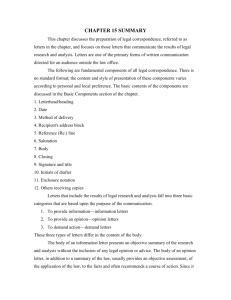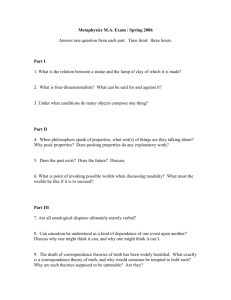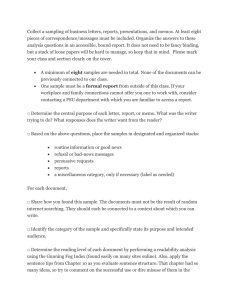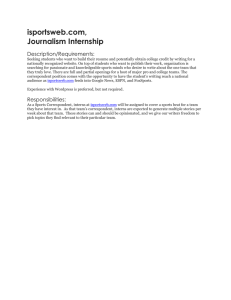Interactional Dynamics Perspective on Academic E-mail Correspondence Olga Karamalak MCSER Publishing, Rome-Italy
advertisement
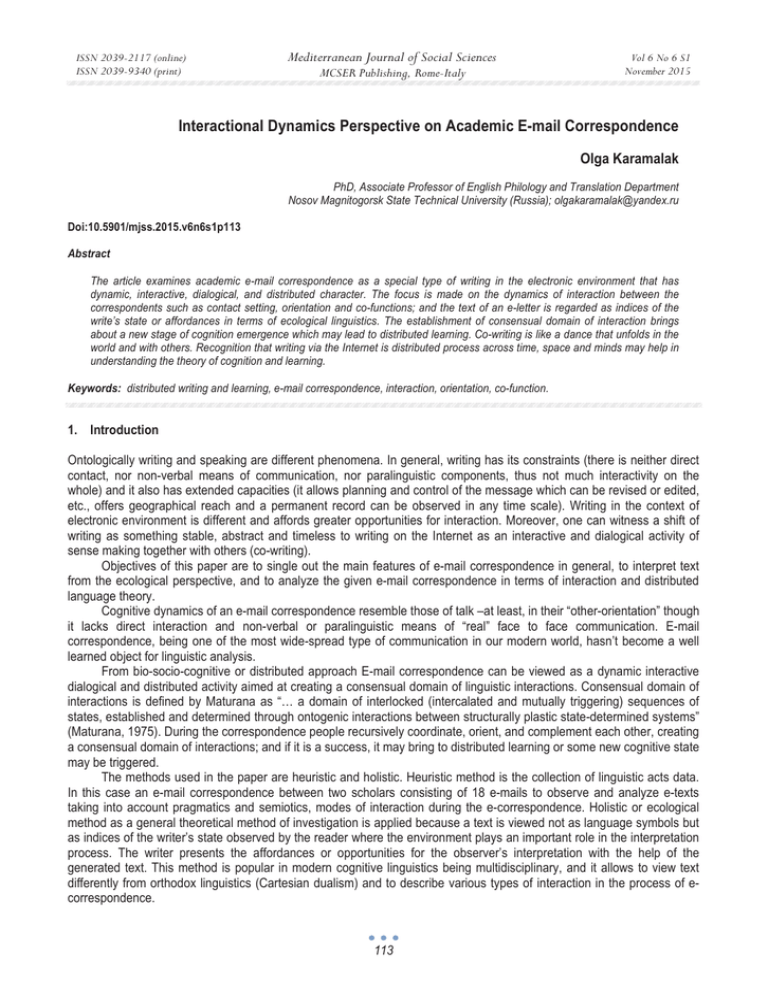
ISSN 2039-2117 (online) ISSN 2039-9340 (print) Mediterranean Journal of Social Sciences MCSER Publishing, Rome-Italy Vol 6 No 6 S1 November 2015 Interactional Dynamics Perspective on Academic E-mail Correspondence Olga Karamalak PhD, Associate Professor of English Philology and Translation Department Nosov Magnitogorsk State Technical University (Russia); olgakaramalak@yandex.ru Doi:10.5901/mjss.2015.v6n6s1p113 Abstract The article examines academic e-mail correspondence as a special type of writing in the electronic environment that has dynamic, interactive, dialogical, and distributed character. The focus is made on the dynamics of interaction between the correspondents such as contact setting, orientation and co-functions; and the text of an e-letter is regarded as indices of the write’s state or affordances in terms of ecological linguistics. The establishment of consensual domain of interaction brings about a new stage of cognition emergence which may lead to distributed learning. Co-writing is like a dance that unfolds in the world and with others. Recognition that writing via the Internet is distributed process across time, space and minds may help in understanding the theory of cognition and learning. Keywords: distributed writing and learning, e-mail correspondence, interaction, orientation, co-function. 1. Introduction Ontologically writing and speaking are different phenomena. In general, writing has its constraints (there is neither direct contact, nor non-verbal means of communication, nor paralinguistic components, thus not much interactivity on the whole) and it also has extended capacities (it allows planning and control of the message which can be revised or edited, etc., offers geographical reach and a permanent record can be observed in any time scale). Writing in the context of electronic environment is different and affords greater opportunities for interaction. Moreover, one can witness a shift of writing as something stable, abstract and timeless to writing on the Internet as an interactive and dialogical activity of sense making together with others (co-writing). Objectives of this paper are to single out the main features of e-mail correspondence in general, to interpret text from the ecological perspective, and to analyze the given e-mail correspondence in terms of interaction and distributed language theory. Cognitive dynamics of an e-mail correspondence resemble those of talk –at least, in their “other-orientation” though it lacks direct interaction and non-verbal or paralinguistic means of “real” face to face communication. E-mail correspondence, being one of the most wide-spread type of communication in our modern world, hasn’t become a well learned object for linguistic analysis. From bio-socio-cognitive or distributed approach E-mail correspondence can be viewed as a dynamic interactive dialogical and distributed activity aimed at creating a consensual domain of linguistic interactions. Consensual domain of interactions is defined by Maturana as “… a domain of interlocked (intercalated and mutually triggering) sequences of states, established and determined through ontogenic interactions between structurally plastic state-determined systems” (Maturana, 1975). During the correspondence people recursively coordinate, orient, and complement each other, creating a consensual domain of interactions; and if it is a success, it may bring to distributed learning or some new cognitive state may be triggered. The methods used in the paper are heuristic and holistic. Heuristic method is the collection of linguistic acts data. In this case an e-mail correspondence between two scholars consisting of 18 e-mails to observe and analyze e-texts taking into account pragmatics and semiotics, modes of interaction during the e-correspondence. Holistic or ecological method as a general theoretical method of investigation is applied because a text is viewed not as language symbols but as indices of the writer’s state observed by the reader where the environment plays an important role in the interpretation process. The writer presents the affordances or opportunities for the observer’s interpretation with the help of the generated text. This method is popular in modern cognitive linguistics being multidisciplinary, and it allows to view text differently from orthodox linguistics (Cartesian dualism) and to describe various types of interaction in the process of ecorrespondence. 113 ISSN 2039-2117 (online) ISSN 2039-9340 (print) Mediterranean Journal of Social Sciences MCSER Publishing, Rome-Italy Vol 6 No 6 S1 November 2015 2. Features of E-mail Correspondence E-mail correspondence is dynamic in character since it runs in series of e-letters, where one complements the other and altogether they create a single whole picture of communication. It proceeds as if in the flow of a dialogue where the outcome of the communication is unknown to the correspondents and depends on the dynamics of their interactions. The second feature of the e-mail correspondence is its interactivity. It presupposes close interaction despite distance which is provided by fast replies. This interactivity shapes what correspondents do, feel, think, and write together. The third thing to stress is its dialogicality or even “double dialogicality” (Linell, 2009). The notion of double dialogicality was introduced by Linell who was inspired by Bakhtin’s dialogical approach and it implies that communication and dialogue are not just between the two people in the conversation, but there is a third party to what they might refer such as traditions, ideas, conversations, practices they previously experienced and which might be applied further in the current conversation. Writing an e-mail we may refer to “remote audiences”, our experience and interactions with them. These “third parties” may be used as aids or partners in the correspondence. E-mail correspondence is obviously a distributed writing in terms that it’s distributed through space (people belonging to different places of the world communicate without any hedge), it is distributed through time in terms that products of the earlier events may transform the later events, it is distributed across members of a social group. We often write together with others –either by borrowing in resources from the Internet –and/or by co-constructing texts. “Language can be traced to how living bodies co-ordinate with the world. On this perspective, far from being a synchronic ‘system’, language is a mode of organization that functions by linking people with each other, external resources and cultural traditions” (Cowley, 2011). It’s distributed in minds taking into account the conception of ourselves as expanded, extended, and dynamic. While communicating our aim is not to be separated from people with our thoughts unknown and closed to others but on the opposite we want to be open, to express ourselves to overcome the boundaries and reach mutual understanding. At the same time our thoughts are shaped in the process of communication, we are who we are socializing with. “We ourselves are dynamically distributed, boundary crossing, offloaded, and environmentally situated, by our very nature <…> A person is not a self-contained module or autonomous whole. We are not like the berry that can be easily plucked, but rather like the plant itself, rooted in the earth and enmeshed in the brambles” (Noë, 2009). A person is not his or her brain and we are not locked up in a prison of our own ideas and sensations. Social and cognitive distribution presupposes that our atmosphere is not separate from others. Our feelings, habits of thinking, patterns of words and so on are parts of a complex web that links us all together; it is our “ecology of thought”. Isaacs argue that this ecology is the living network of memory and awareness, one that is not limited to any single person but is in fact held collectively. Out of this ecology comes the collective atmosphere in which we all live and work (Isaacs, 2009). Bakhtin introduced the term “existence from without”. “A word (or in general any sign) is interindividual. Everything that is said, expressed, is located outside the “soul” of the speaker and does not belong only to him (or her) (Bakhtin, 1986). “I” exists and shows up only in interaction with or relation to “You”. Outside there are two phenomena “I” a “Non I”, inside they appear as one inseparable whole. “I” as such does not exist without “You” and there is no pre-given “I”, it is born, formed, shows up only in relation with “You”, where you is a part of my environment. So we are plugged-in organisms. Our selves, our attitudes and motivations are discursively constructed, that is they are created, developed and maintained in interaction with others (Linell, 2009) and ourselves. Co-writing is interaction in the writing environment where we orient one another. This opens up a new set of questions –and problems. Among this is that of how we should theorize text of an email correspondence and how we use co-constructed writing for learning or, in Maturanian terms, how the correspondence shapes the rise of a consensual domain. 3. Text of E-mail The method is based on the inscriptions investigation from pragmatics and considering the outcome – giving rise to a consensual domain construction, new state of mind arising, and possible distributed learning process occurring. The key lies in how to theorize the resulting inscriptions of the E-mail correspondence. To investigate this, we need a method –one that does not treat text as “language” fixed by a code, a set of definite structures to be analyzed – but, rather, an investigation that brings into account what acts of writing and their consequences mean for those involved. Basically a view where we focus on – not texts –but how these interact with cognitive dynamics. 114 ISSN 2039-2117 (online) ISSN 2039-9340 (print) Mediterranean Journal of Social Sciences MCSER Publishing, Rome-Italy Vol 6 No 6 S1 November 2015 On the activity theory view, they are mediational means. As Peter Jones claims in his critical paper there’s no code when external speech is turned into inner speech. In fact there’s no internalization or appropriation. Text of an eletter is not a mediating means because if it were so we would continue the language myth and a telementation theory, that a language sign mediates between person A and B and B internalize the content and learn. Thus language constitutes a self-contained realm of meaningful forms – the idea we are totally against (Jones, 2009). Following Gibson’s ecological approach to perception, the body of the e-mail correspondence is not sense-making symbols by themselves, but the affordances or opportunities for behavior which are meaningful to an observer. “The affordances of the environment are what it offers the animal, what it provides or furnishes, either for good or ill” (Gibson, 1979). There appears a question if the affordances are properties of the environment or the organism. Gibson himself answers this question the following way “An affordance is neither an objective property nor a subjective property; or it is both if you like. An affordance cuts across the dichotomy of subjective-objective and helps us to understand its inadequacy. It is equally a fact of the environment and a fact of behavior. It is both physical and psychical, yet neither. An affordance points both ways, to the environment and to the observer” (Gibson, 1979). A. Chemero comes to the conclusion that affordances are not properties of the environment. They are relations between particular aspects of animals and particular aspects of situations. Properties of the environment are not affordances in the absence of complementary properties of animals. Affordances belong to animal-environment system (Chemero, 2009). Thus the text of an e-mail doesn’t contain affordances by itself or affordances are not the properties of the e-mail, they occur in the relation between the e-mail and the observer (a person who perceives it). What we perceive is not the text itself but the relation between us and the text. According to radical empiricist, perception is direct because it is an act that includes the thing perceived. “Perceivables are relations between perceivers and aspects of situations” (Chemero, 2009). Thus reading an e-mail we perceive the relation between us and the e-mail and another person perceives the relation between him or her and the same text so that perceptions can remain private. The main issue here is what we perceive is not in the environment alone, it is in the relation between an observer and the environment. These relations are open and dynamic, that is why text interpretation can be different every time it is perceived. On the Maturanian alternative, the text of the e-letters is indices of an observer’s states. In contrast to solo-writing, these inscriptions are more than first correspondent’s indices. They are also ‘external resources’ that influence the dynamics of the three as an extended (or distributed) text-creating system (the first correspondent revises his wordings, they influence later versions of him who comes back to and revises the text; they also influence the second correspondent who is reading them and the third party, who is an “objective observer” who is reading and analyzing the correspondence between the two). Therefore, we orient to – not just the same inscriptions –but to inscriptions that, to an extent, have similar effects (both on ourselves and on each other). And while indices of the observer’s states they are also inscriptional structures that function as external resources. 4. Two Modes of Coordination Two modes of coordination can be observed in the e-mail correspondence as in any other activity according to Imoto who calls them horizontal and vertical (just for the convenience of understanding). Horizontal coordinations are related to the interactions of the organism with its medium (the environment and the other writer as a part of the environment); vertical coordinations are explained as the interactions with its own internal states that are originally derived from the horizontal coordinations and then recursively coordinated through the nervous system as if they were another independent domain of interactions (Imoto, 2010). Reflection, planning, revision, and editing can be referred to vertical coordinations. The first correspondent writing a first e-mail in the sequence coordinates mostly vertically, that is with him/herself, but at the same time dialogically based on the former interactions with others and priming the possible interactions with the second correspondent, then a letter is produced as indices of the write’s inner state and resources or affordances for an observer directed to the second correspondent. The second correspondent’s behavior is coordinated horizontally and vertically, as a consequence his or her behavior is changed. The notion of “zeitnot” (time pressure) is crucial in understanding that the written message is perceived “here – and – now” and explains why the writer’s state of ideas is never totally equal to the one he or she has had before. The first correspondent and the text that he/she is creating can be seen as a ‘system’. Thus it becomes, broadly, indices of the first correspondent’s states (or of ideal states –which result from both indexical acts and subsequent revision). “The relation between a person who perceives the e-mail and a written text that influences the dynamics of the three (a reader, a writer, and an onlooker) can be viewed as an extended text-creating system (Karamalak, 2012). 115 ISSN 2039-2117 (online) ISSN 2039-9340 (print) Mediterranean Journal of Social Sciences MCSER Publishing, Rome-Italy Vol 6 No 6 S1 November 2015 5. E-mail Correspondence Analysis This new approach of distributed writing can be put into an applied frame of e-mail correspondence investigation or analysis. The e-mail correspondence consisting of 18 e-mails between two scientists, a professor and a PhD student is under the current analysis. As a result the following steps of a consensual domain rising in an e-mail correspondence can be pointed out. 1) A system coupling with another system (two correspondents). 2) Mutual frame of reference (shared inscriptional co-indexing, knowledge background, mutual issues of concern, limits of each other). For Maturana (1978), when encountered (in revising or in reading the other), it sets off perturbations that echo the limits of the other and, at the same time, show our attempts to extend boundaries. 3) Mutually triggering of inscriptional sequences. There are different types of interactions that lead to the emergence of a new cognitive state such as contact setting, orientation and co-functions. a) Contact setting and interaction (asking and answering questions, sharing knowledge in terms of ideas, bringing examples, dialogical co-action) is an inscription produced by the first correspondent that gives rise to an observable effect in an inscription by the second correspondent. The first stage of interaction includes the following: contact setting, introduction about oneself (“I am a PhD Student <…> I am currently collaborating with <…> What fascinates me is that <…> I switched my interest from <…> I took a summer course …”) and bridging the gap between “I and You” by mentioning the other correspondent (“it was very fortunate to have you as a guest …”). The second e-letter (the response) shows us the reply or a positive reaction on the contact setting (“I would be pleased to add you…”) some kind of orientation (“If you have any thoughts on how we should conceptualize…”). As an observer we can judge about the limits and the desire to expand the boundaries thus motivation for the further interaction the first author is a beginning researcher and the second one is prominent but at the same time the mature scientist also has some limitations (“But I have no knowledge of anyone who has written about any such concept …”). The first stage of interaction can be characterized as a simple and very cautious provided with probing or feeling the ground, so to speak. The most important thing here is acceptance or non-acceptance of the partner. One person makes one step towards the other with the desire to interact and waits for the reaction of the other. In gestures it could be seen through stretching a hand and handshaking. In writing we cannot judge about these dynamics by body movements, the only thing we can judge is by the dynamics of the text. First, two correspondents seem to be “far away” from each other, there’s not much mutuality, only motivation, desire to learn something new, and interest in the common issue. However this is more than enough for a good beginning. The first time of interaction can be awkward because people are adjusting themselves to each other. It might resemble a play in the ball. Every time a person starts playing with another one it takes time till you see some progress in playing. First you need to adjust the impact force to the one of your partner's, this adjustment happens recursively. Then the play can be progressed and improved. b) Orientation (prompts that may influence the participants, giving food for thought, a change in the flow of ideas) is an inscription by the first correspondent that evokes a change in how the second correspondent subsequently inscribes. The fourth letter is mostly of orientation character and gives guideline in what direction to move in the discussed field of research (“if I were doing this, I would start out with…”), refers to some papers to read and gives ideas and food for thought. Cognitive domain of interaction is established from the very first stage of interaction between the two people, but during the stage of orientation it is established to the full. Two writers of the e-mail correspondence involved are coupling, trying to fit each other to compensate the gap of knowledge, cooperate in a successful manner because they are both interested in it. c) Co-functions where an inscription by the first correspondent prompts explicit agreement/disagreement by the second one and on the opposite. Co-functions occur when an oriented organism becomes active to that degree that it can orient the orienting one so when we witness recursive orientation. The stage of co-functions arises when the activity can be called collaborative (“… let’s try to work at it a bit collectively <…> we should gain from thinking through some of these things together”). As a famous proverb says “two heads are better than one” or “four eyes see better than two”. It is commonly known that working as a group can enhance the effectiveness of decision making, just as it can enhance the effectiveness of problem solving. William Isaacs in his book “Dialogue, the art of thinking together” speaks about the “collective intelligence” (CQ); together we are more aware and smarter than we are on our own [Isaacs, 1999]. Bohm also says about undivided or unbroken wholeness in flowing movement, non-locality or entanglement. 116 ISSN 2039-2117 (online) ISSN 2039-9340 (print) Mediterranean Journal of Social Sciences MCSER Publishing, Rome-Italy Vol 6 No 6 S1 November 2015 According to his ideas thought and knowledge are limited, but the boundary can always be extended. Bohr understood it in terms of yin/yang or what he called complementariness. Two organisms change in the way to complement each other like two pieces of puzzle. If this complementarity is achieved, then from this unity something knew is achieved, knew ideas are generated, which couldn’t have been worked out without the interaction and consensual domain establishment (Bohm, 1985). “We cannot study creativity by isolating individuals and their works from the social and historical milieu in which their actions are carried out…what we call creative is never the result of individual action alone” (Csikszentmihalyi, 1988). This distributed learning is a spontaneous system that arises as an order from chaos since both writers cannot predict the emergence of this new system as Maturana says discussing spontaneity versus purposefulness (Maturana, 2011). When the correspondents start co-writing they cannot predict the outcome of their e-mail correspondence and what kind of learning will emerge or in other words what will be learned as a result of this co-writing. The learning domain is chaotic because an observer is not able to predict its arising. Later on the observer realizes this new learning domain of interactions and the chaos is not chaos any more. It turns into a system. Starting the e-mail correspondence people feel fragmented but conversing there come to feel the “wholeness” and rise to a new level of understanding of the problem they discuss. This type of learning is not when one person orients the other and informs the latter, it is a generative and creative learning, when they come to the idea which has not been reached without their interaction. Further, we can say that without this co-ontogeny between the correspondents, certain behaviors would not have arisen. Within the co-ontogeny the behaviors of the correspondents become consensual – i.e. they have created a consensus about the coordination of their behaviors. Consensual domain is the juncture between two observers in coupling is itself a higher-order domain of description. The notion consensual is something like mutual and co-operational. Languaging is like a dance, mutual adaptation to one another’s actions, orientation in conversation, cooperation. "Dialogue is about common participation in which we are not playing a game against each other but with each other" (Bohm, 1989). For this kind of distributed learning in terms of “thinking together” to make a breakthrough a communication should be conducted with some ethics and human values: 1. the atmosphere of friendly relations, trust, and respect; 2. common ground and compatible skills of the people involved; 3. motivation, commitment and dedication to the process cannot be underestimated as well; 4. readiness or desire for lots of give and take, making a true dialogue a recursive process of interactions. As an observer we can witness learning or new ideas emerging concerning the issue discussed in the correspondence from the sixth letter when the first writer draws back to the example brought by the second writer and comes up with the idea of non-local learning as taking habits together. It is interesting to mention that the writers begin to feel and observe the process of learning mentioning about it from the ninth letter (“What I have learned about depends on my communication with you. For me, I also constantly draw upon my own feelings, previous experiences and especially current happenings to make meanings of what you have said. That is why I go back to our previous E-mails whenever a new thought emerges”). What happens is that the correspondents are reading, writing, and thinking “out of selves” together with each other. 6. Distributed Learning Distributed learning in the process of co-writing can be considered as the climax of consensual domain establishment. It occurs when two writers adapt to each other and complement each other. Knowledge rising or distributed learning defined in terms of how the context of the first correspondent’s behavior influences the second correspondent’s behavior such that they come up with something that neither was likely to reach alone. Finding the way to go on in one direction and creation of the 3rd. The value of coming to “cooperate and understand the third”. It is useless to understand the other, it’s better to cooperate and understand the third. The climax of the consensual domain is when the similar understanding and cooperation is triggered and knew knowledge emerges. Consensus is achieved thanks to cooperational integration when isolation of I or ego is overcome and the correspondents are ready to go to the higher level of understanding the issue and create or generate new knowledge. Dialogue or in our case shared inscriptional coindexing is a path to greater wisdom and learning. Bohm (1989) refined dialogue to a creative art. "Dialogue makes possible a flow of meaning in the whole group, out of which will emerge some new understanding" (Bohm, 1989). This understanding of a dialogue is close to Bakhtin’s ideas that participants of a dialogue create a new whole within common meaning space. 117 ISSN 2039-2117 (online) ISSN 2039-9340 (print) Mediterranean Journal of Social Sciences MCSER Publishing, Rome-Italy Vol 6 No 6 S1 November 2015 Learning is not digestion of something. As Noë states consciousness is not something that happens inside us. It is something we do or make or achieve. It can be compared with with dancing. “The locus of consciousness is the dynamic life of the whole, environmentally plugged-in person or animal” (Noë, 2009). He proposes that human experience is a dance that unfolds in the world and with others. Mutual coordination is extended to action in the form of improved performance. In the e-mail correspondence the e-mail itself is not something one correspondent does to another person, it is something they do together. Together they achieve new ideas that neither party could have imagined before starting. Conversing, the energy of our differences and similarities is channeled toward something that has never been created before. It brings us to a greater common sense and is thereby a means for accessing the intelligence and coordinated power of people. The intention of dialogue is to reach new understanding and, in doing so, to form a totally new basis from which to think and act (Isaacs, 1999). Dialogue not only raises the level of shared thinking, it impacts how people act, and, in particular, how they act all together. In the dialogue there happens some transformation not only of the relationship between people, but also the very nature of the consciousness. Isaacs says about “generative dialogue” that “emerged as people let go of their positions and views <…>They found themselves attending simply to the flow of conversation, a flow that enveloped us and lifted us to a new level of shared understanding about dialogue” (Isaacs, 1999). 7. Conclusion From bio-socio-cognitive or distributed approach E-mail correspondence can be viewed as a dynamic interactive dialogical and distributed activity aimed at creating a consensual domain of linguistic interactions. The text of the academic text of e-mails is not a “language” fixed by a code, but, affordances that in affords us to generate the meaning only in the process of interaction. What we perceive is not the text containing information but the relation between us and the text. Having analyzed a series of e-mails, three main stages were outlined: a system coupling with another system (two correspondents); mutual frame of reference (shared inscriptional co-indexing, knowledge background, mutual issues of concern, limits of each other); mutually triggering of inscriptional sequences. There are different types of interactions that lead to the emergence of a new cognitive state such as contact setting, orientation and co-functions. Contact setting and interaction (asking and answering questions, sharing knowledge in terms of ideas, bringing examples, dialogical co-action) is an inscription produced by the first correspondent that gives rise to an observable effect in an inscription by the second correspondent. Orientation (prompts that may influence the participants, giving food for thought, a change in the flow of ideas) is an inscription by the first correspondent that evokes a change in how the second correspondent subsequently inscribes. Co-functions occur when an oriented organism becomes active to that degree that it can orient the orienting one so when we witness recursive orientation. This distributed learning is a spontaneous system that arises as an order from chaos since both writers cannot predict the emergence of this new system. Recognition that writing via the Internet is distributed process across time, space and minds may help in understanding the theory of cognition and learning in general. Writing via the Internet environment differs from traditional writing and it needs a new methodology for its analysis. Writing is transforming with the expanding of media environment and acquiring some dynamics of a talk. Electronic writing being less emotional than speaking is acquiring more emotionality with the use of icons. Despite the fact that people are more and more communicating in a written form the dynamics of their interactions are not studied yet thus challenging us to tackle this problem. The research can be expanded in the examination of other forms of co-writing and conversing in the writing environment through the Internet like Facebook, twitters, different blogs, etc. 8. Acknowledgement This research was supported by DAAD and the Russian Ministry of Education ʋ3692. References Bakhtin, M. (1986). Speech Genres and Other Late Essays. University of Texas Press. Bohm, D. (1985). Unfolding Meaning. A Weekend of Dialogue with David Bohm. London: Routledge. Bohm, D. (1989). Meaning And Information, In: P. Pylkkänen (ed.): The Search for Meaning: The New Spirit in Science and Philosophy, Thorsons Publishing Group, Wellingborough. 118 ISSN 2039-2117 (online) ISSN 2039-9340 (print) Mediterranean Journal of Social Sciences MCSER Publishing, Rome-Italy Vol 6 No 6 S1 November 2015 Chemero A. (2009). Radical Embodied Cognitive Science. Cambridge, Massachusetts: The MIT Press. Cowley S. J. (2011). Distributed language. Amsterdam / Philadelphia: John Benjamins Publishing Company. Csikszentmihalyi M. (1988). Society, culture, and person: A systems view on creativity. In R. J. Sternberg (Ed.), The nature of creativity N. Y.: Cambridge University Press, pp. 325 – 339. Gibson J. (1979). The Ecological Approach to Visual Perception. Boston: Houghton-Mifflin. Imoto S (2011). The Logic of Maturana’s Biology // Constructivist Foundations. An interdisciplinary journal. Special Issue. The work of Humberto Maturana and Its Application Across the Sciences. V 6, ʋ 3 July 2011, pp. 325 – 333. Isaacs W. (1999). Dialogue: The art of thinking together. A pioneering approach to communicating in business and in life. N. Y.: Doubleday, Random House, Inc. Jones P. E. (2009). From ‘external speech’ to ‘inner speech’ in Vygotsky: A critical appraisal and fresh perspectives. Language and Communication 29. Elsevier, pp.166 – 181. Karamalak O. A. (2012). Cognitive Dynamics of E-mail Correspondence // Book of Abstracts. 1st International Conference on Interactivity, Language and Cognition. University of Southern Denmark, Odense , September 12th to 14th, 2012 / Ed. Sune V. Steffensen, Sarah B. Pedersen and Christian M. Johannessen, University of Southern Denmark, p. 35. Linell P. (2009). Rethinking language, mind, and world dialogically: Interactional and contextual theories of human sense-making. Information Age Publishing, INC. Charlotte, NC. Maturana H. R. (1975) The organization of the living: A theory of the living organization. International Journal of Man-Machine Studies 7. Maturana H. R. (1978). Biology of Language: the Epistemology of Reality / G. A. Miller & E. Lenneberg (Eds.) Psychology and Biology of Language and Thought: Essays in Honor of Eric Lenneberg. N. Y.: Academic Press, pp. 27 – 63. Maturana H.R. (2011). Twenty Years After. Preface by Humberto Maturana Romesín to the second edition of De Máquinas y Seres Vivos. Origins and Implications of Autopoiesis. Humberto Maturana theory of Autopoiesis. Constructivist Foundations. V 6, ʋ 3 July 2011, pp. 295 – 306. [Online] Available: http://www.univie.ac.at/constructivism/journal/6/3/293.maturana Noë A. (2009). OUT OF OUR HEADS: Why you are not your brain, and other lessons from the biology of consciousness. Hill and Wang, New York. 119

